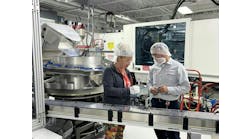1997 IW Best Plants - Alcatel Telecom
At A Glance - Alcatel Telecom, Raleigh, N.C.
- 100% of production workforce in self-directed work teams.
- Key suppliers on a just-in-time basis.
- Cycle time for a typical product reduced by 75% in the last five years.
- Energy consumption per unit of production decreased by 63.6% in the last five years.
- Five benchmarking studies in the last three years.
- In-plant defect rate reduced by 40% in the last five years.
- Process-development and concurrent-engineering efforts involve production employees.
- Kaizen blitz programs used to achieve major improvements in performance.
- Financial rewards provided for both team-based and individual performance.
- Total supplier base reduced by 75% in the last five years.
- 53% of plant's total part numbers stored at point of use.
- Annual sales per employee increased by 155% in the last five years.
Electronic technician Mary Ann Miller admits she was once bad news for management at the Raleigh, N.C., plant where Alcatel makes equipment for broadband telecommunications and data networks.
"I was a troublemaker," she says. "Management did not like me because I would push ideas for changes that I thought would solve some of our production problems. I wouldn't stop pushing, even though all management wanted was for me to be quiet and do my job."
Miller -- a 16&1/2-year veteran of the company, which is a division of Alcatel Telecom -- says attitudes are different now. Both management and production employees are committed to process improvements via employee involvement and empowerment. Now her troublemaking past is simply a story she likes to repeat when setting up new teams to remind them of how far the plant has come in its pursuit of quality, efficiency, and productivity.
"In the old days, they didn't want to deal with the problems that I had," says Miller. "They didn't want to change things -- even simple problems that wouldn't take much to change. Today we encourage people to be fearless in bringing forth their ideas and to keep on selling them until they're bought."
The old days at Raleigh go back to 1957, when the plant was founded as the Kellogg Communications Div. of ITT. ITT sold its telecom interests to CGE (Compagnie Gnrale d'Electricit), as the Paris-based Alcatel Alsthom Group was known in 1987.
The Raleigh plant is part of Alcatel Network Systems, a business within Alcatel Telecom and part of the Alcatel Alsthom Group, a global leader in telecommunications with more than $30 billion in annual sales. The business focus of Alcatel Network Systems is on providing telecommunications products and services in the U.S. -- involving broadband telecommunications and data networks.
The team concept emerged at Raleigh in 1988 when the plant became part of Alcatel Network Systems.
"We began with a two-day total-quality-awareness training class," recalls William Franch, director of manufacturing.
Like many early forays into team building, the effort had to overcome culture problems, but the plant demonstrated a talent for capitalizing on adversity. After finding that team objectives weren't being met, the Raleigh plant pulled back for a year to reappraise its team-building strategy. Study of the implementation efforts revealed that part of the problem was in the mistaken notion of some managers that teams were just another flavor of the old "command and control" technique, says Franch.
After a period of retraining and rededication, the Raleigh plant resumed its team-based journey in 1991. "We did it with a special urgency, since that was the year that Rockwell International's Transmission System Div. was folded into Alcatel Network Systems," says Gary Bushman, manager of quality assurance and manufacturing engineering. "We realized that with the merger of the two businesses, it was initially uncertain whether both would survive. We were aware of the possibility of downsizing, and we knew that when two independent companies are brought together, all the facilities will be appraised to see what redundancies can be eliminated."
Adds William King, senior director of operations, "We didn't set out to be one of IndustryWeek's 10 Best Plants winners -- we merely wanted to survive!"
As the production operations implemented team activities, it became apparent that managers did not have a monopoly on the culture-change problems. The direct-supervision model of coordinating activities was as deeply ingrained among some of the production employees as it was among some managers.
Second-shift manufacturing manager Margaret O'Neal says the tradition of having a central authority that coordinated all tasks by telling people what to do was a special challenge to the team-building process.
"When we first began to emphasize teams, people were reluctant to participate because they were so accustomed to someone telling them what to do -- and not giving them the opportunity to get involved and do it themselves. That was a big change."
It is obvious that employees at Alcatel no longer check their brains at the door. Seven continuous-improvement teams, two work-center teams, and a test team that she facilitates draw their members from the 63 employees who report to O'Neal.
"The employees are Alcatel's most valuable resource, and getting total involvement is the issue behind our success," she says.
One metric of that success can be expressed in terms of sales. "The teams have been instrumental in the sales increase of 150% from 1992," says Wayne Tindle, principal engineer for total quality.
Miller says that the need to be patient and persistent may be the most important lesson learned in Alcatel's journey to teams: "Don't give up -- it is something that is not going to happen overnight. If you have a problem with implementation, step back, review what you're doing, and compare that with the best practices in that area."
The importance of training is emphasized by O'Neal. "Providing the knowledge and skills on an ongoing basis is required for a continuous-improvement effort to succeed."
The Raleigh plant mandates a minimum of 40 hours of training annually. The plant continues to build its performance and quality successes on employee involvement and empowerment. For example, it has more than 36 teams, and all full-time production employees are members of continuous improvement teams (CITs), says Tindle.
In 1996 CITs achieved 58 team goals, each reflecting a 15% to 20% improvement in a major process metric such as quality, cycle time, or production output.
"Our total-quality practices are the foundation of all team activities," explains Tindle, and "all team goals are aligned with the corporate five-year business plan, Vision 2002."
Driving the whole team process are a reward/recognition system and a spirit of fun. "That's needed if people are to enjoy their work," says King.
CITs are staffed by eight to 10 employees in a defined work process, with new leaders selected from team members every six months. Each team has one or two continuous-improvement goals that are aligned with the corporate business goals. However, the tasks they work on to achieve the goals are selected by the teams themselves with the help of a part-time facilitator. Production workers account for about 30% of the facilitators, a role originally envisioned for support employees only. Each CIT leader, along with one team member, makes monthly progress reports to an operation-leadership team consisting of the director of manufacturing, manager of quality assurance/manufacturing engineering, and two additional members of management.
The support staff is organized into seven cross-functional operations-process teams (OPTs). An OPT will support a defined process and typically consists of one or more representatives from support functions (manufacturing engineering, quality engineering, test engineering, product engineering, planning, and production management). Team leaders report to the Operations Management Council chaired by King.
In 1995 the plant began using kaizen teams of support and production employees to rapidly snare significant improvements. Nineteen events, each spanning a three- to five-day period, were concluded by the end of 1996.
The quality requirements are driven by the telecommunications industry's extensive technical, quality, reliability, and performance standards. Since telephone companies are now open to competition, their use of Alcatel's products to generate service revenues translates into a growing portfolio of demands for product features from Alcatel. For instance, quality requirements for hardware and software used in the telecommunications network are so stringent that 100% telephone-service availability 24 hours a day is required.
That industry objective is translated into a product-performance design goal of no more than one hour of downtime in 20 years. Alcatel's goal is to achieve these levels of quality and reliability in its products and ensure that quality is maintained throughout the product life cycle. Warranty coverage extends for five years on most products. ISO 9001 certification was achieved in 1993. In 1994 the plant received the Shingo Prize for excellence in manufacturing, says Tindle.
The plant's business functions include development, manufacturing operations, customer service, and product-line management. Products designed, manufactured, and serviced at Raleigh include SONET transport multiplexers, ADSL broadband equipment, digital cross-connect equipment, and network-management software. Manufacturing specifically consists of the assembly and test of printed circuit boards (PCBs) followed by configuration into rack-level systems. In addition to direct sales to external customers, the manufacturing operation provides products to the other Alcatel final-assembly plants. Customer service provides 24-hour technical support for product lines, customer applications, marketing proposals, and customer repair, as well as production testing for all switching equipment.
Team-based activity has significantly improved internal processes. For example, six material staging areas have been eliminated -- reducing cycle time by 70%, reducing scrap by 50%, and increasing product final yield by 50%.
"Previously we would typically build the machine portion of a product, queue it off line, and then build the manual assembly," Franch explains. "Then there would be another queue before the testing step. By eliminating the queues between major process points, the teams were able to make substantial improvements in quality, cycle time, and work-in-process numbers. Cycle time, which was as high as 25 to 30 days in the early 1990s, dropped to an average of 5 days in early 1997 and is now under 21/2 days. Both our cross-functional and kaizen teams are continuing the attack."
Other process improvements come from the elimination of 100% system environmental testing and the need for PCB burn-in. Franch says process and product-design improvements have made it possible to eliminate the traditional steps of testing a product under power at temperatures of 50 C to 70 C.
"One factor is the quality improvements in semiconductors. So unless you're very unlucky or have some unqualified suppliers, these problems have been eliminated."
According to Franch, process improvements have been achieved by using many different techniques -- such as failure analysis, Taguchi experiments, and statistical process control through continuous-improvement teams, kaizen teams, and operations-process teams (engineering-level cross-functional teams representing each process area).
The OPTs focus on large process improvements such as reduction of floor space (8,000 sq ft saved and converted to manufacturing space), cycle-time improvements (from three to four weeks down to less than five days for PCBs), setup reductions (from four to eight hours to less than one hour), and process improvements involving product design (parts-per-million defects pared by 40%). The plant will need to sustain its teaming efforts to meet a twofold challenge that King is projecting for the next five years.
"We expect to double or triple the size of the business, and we hope to do that in our current facility."



